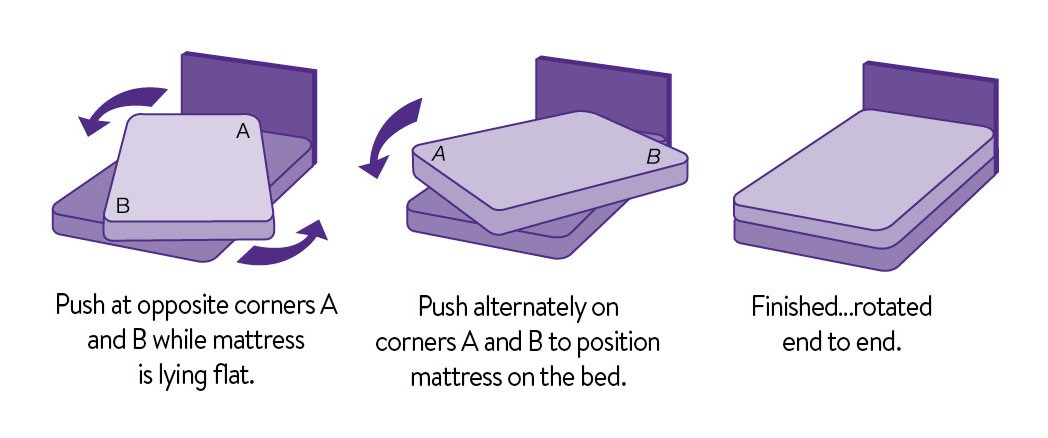What to do when you get a new mattress

Body Contouring Your Mattress
In a pair of shoes, your feet naturally contour and shape to fit inside them snuggly over time. Your bed is exactly the same – it eventually moulds, cradles and contours to your body shape for maximum comfort.
Your mattress may take several weeks to mould to your unique shape, so don’t be concerned when you lie on it for the first time and it’s not what you remember from the bed you trialled in store. Your bed will also develop body impressions over time.
Body Impressions on Your New Mattress
It’s your unique stamp on the new mattress and it’s perfectly natural when you’re wearing a bed in. What happens? Comfort layers on top of your mattress will naturally adjust as you use your bed more. Normal levels for this contour adjustment are between 25mm – 35mm but if it depends on your body shape and size.

What’s also important is prolonging the life of your bed. Looking after your bed springs, the vital support system and the foam, the comfort layer is vital for mattress maintenance.
Thankfully it’s as easy as rotating the mattress every two weeks for the first two months then every three months thereafter. This initially helps your mattress settle and evens out the wear and tear as time goes on so you’ll extend the life of your bed.
Mattress Turning Instructions

Base Assembly

The Do’s and Don’ts for New Mattresses
Do:
DO turn and/or rotate your mattress frequently.
DO carry your mattress flat or on its side. This is a job for two people.
DO use a mattress protector. The use of a washable, good quality mattress protector will help keep your mattress clean. A waterproof sheet under the mattress protector may be useful for children’s beds.
DO air your bed. Airing your bed periodically by leaving bed linen off for several hours will allow condensation caused by body heat to evaporate.
DO vacuum your bed regularly using low suction.
DO treat spills and stains as soon as possible. Gently scrape away soiling or mop any liquid. Use a clean, damp cloth and dry in shade away from direct heat. Allow to dry thoroughly before re-use.
DO firmly push in all base legs/castors supplied with your new base. This will enhance product life and provide optimum comfort.
DO replace your base when purchasing a new mattress. The base supports the entire mattress and old springs lose their strength and support. By not using the intended base with your new mattress, damage can occur to the product. This is not a manufacturing fault.
DO dispose of all plastic packaging immediately and appropriately. Bags are polyethylene and can be recycled, but are dangerous for young children. Please ensure the plastic is properly discarded.
DO store your mattress in a breathable bag.
DO ensure your mattress and base are appropriately packaged when transporting or storing your bed to prevent structural damage or condensation which can cause dampness and mildew, damage from which is excluded from the warranty.
DO upkeep and clean your mattress and sheets
Don’t:
DON’T place plastic bags near children as they could cause suffocation.
DON’T remove border labels or tags. The border label on your new bed contains information to help identify the mattress you own, should you have any future concerns.
DON’T use cleaning agents on your mattress. Chemicals contained in some cleaning agents may damage the fabric or underlying materials in your mattress. To remove a stain or mark, use a clean damp cloth only.
DON’T bend or jump on your mattress under any circumstances. This may cause damage to the internal construction of your mattress.
DON’T smoke in bed.
DON’T saturate fabric with water or other cleaning liquid.
DON’T use dishwashing or laundry detergent.
DON’T scrub with a stiff brush.
Get a Better Nights Sleep with SleepMaker
If you need pointers on purchasing a new mattress or have just purchase a new mattress, discover the SleepMaker Sleep Guide for tips and resources on getting a good nights sleep. Alternatively, you may want to check out our Luxury Edit, Performance Edit or Essentials Edit of our mattresses.
What’s the Best Mattress Size For Me?
Is a spring mattress or foam mattress better for me?
Is a soft or firm mattress better for me?
When is the right time to transition to a “big kids bed”?
When should I replace my bed?
